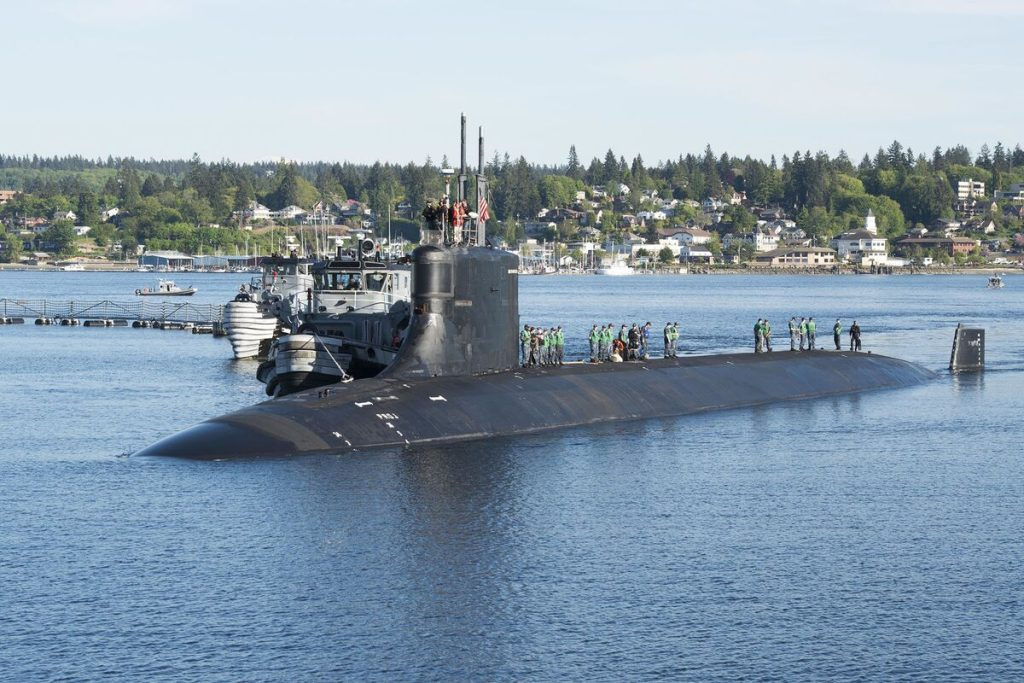The USS Connecticut, a premier submarine that struck an underwater mountain in the South China Sea 19 months ago, won’t be back in service until early 2026 at the soonest, according to the US Navy, adding to a backlog of maintenance overhauls as the US faces a growing Chinese fleet.
The Connecticut, one of three advanced Seawolf submarines, hit the uncharted seamount on Oct. 2, 2021. The repairs to the bow and lower rudder will cost an estimated $80 million, according to the Navy. That’s a modest sum by Pentagon standards, but the long wait for the vessel’s return to service highlights problems with maintenance at the Navy’s four shipyards.
“The Connecticut’s repair saga underscores the Navy’s lack of repair surge capacity,” said Diana Maurer, a director of the Government Accountability Office’s defense readiness evaluations. “That in turn raises questions about how the Navy would execute battle damage repairs in the event of conflict.”
Delays hobbling the readiness of Navy submarines have been documented repeatedly in recent years by the GAO.
Defense officials and lawmakers consider the US submarine force a key advantage over a numerically larger Chinese navy. But the GAO said in a 2022 summary about US capabilities against China that the Navy lost 10,363 operational days from 2008 through 2018 — the equivalent of more than 28 years — “as a result of delays in getting into and out of the shipyards.”
Another recent GAO assessment found that from fiscal year 2014 to fiscal 2020, Navy submarines had spent 9,563 more days in depot maintenance than expected.
The Senate Armed Services Committee’s top Republican, Roger Wicker of Mississippi, said in a tweet Wednesday that the five-year repair timetable reported by Bloomberg News for “one of our most formidable submarines” is “a reminder of the kinds of monumental investments we need to make in maritime infrastructure.”
The Connecticut, built by General Dynamics Corp., was commissioned for service in 1998. An investigation found its accident, which caused minor injuries to 11 sailors, was preventable. The vessel’s commander, executive officer and senior enlisted officer were relieved of command.
Taiwan, Sea Lanes
Now, it’s among 18 of the Navy’s 49 fast-attack subs — or more than one-third of that fleet — that are out of service, either in depot maintenance or awaiting to enter that phase, according to Navy records. Fast-attack subs fire torpedoes and Tomahawk cruise missiles, which would make them crucial vessels in a potential fight against China over Taiwan or South China Sea lanes.
“Limited public shipyard capacity has delayed a sooner return-to-service of this unique, special-missions submarine” so it “will be out of service an unacceptable five years,” said Brent Sadler, the Heritage Foundation’s senior research fellow for naval warfare and a Navy veteran with numerous submarine tours.
Maurer of the GAO said the Navy may be giving top priority “for scarce shipyard space” to aircraft carriers and ballistic-missile submarines, “which means attack subs are more likely to rack up idle time waiting to get into an available dry dock.”
The Connecticut is one on the US’s three nuclear-powered Seawolf-class vessels, the service’s largest attack subs, which were designed to fight the Soviet Union. The Navy describes the class as “exceptionally quiet, fast, well-armed, and equipped with advanced sensors.” It has eight torpedo tubes and can hold as many as 50 weapons in its torpedo room.
Ronald O’Rourke, a naval analyst with the Congressional Research Service, said the delay reflects in part “a product of the complexity of modern warships — and thus the complexity of the work needed to repair damage to them.”
The Connecticut is currently dockside at a naval shipyard in Washington state awaiting the start of a maintenance period that was to begin in February. It’s now expected to begin next month after the completion of improvements to harden the dry dock where it will be repaired against earthquake tremors, the Navy said in a statement.
“Some of the primary drivers of submarine maintenance delays are planning, material availability, and shipyard execution,” according to the service. The Navy’s “submarine sustainment leadership is executing multiple initiatives to address other drivers of maintenance delays.” it said.
Source : TheMalaysianReserve

